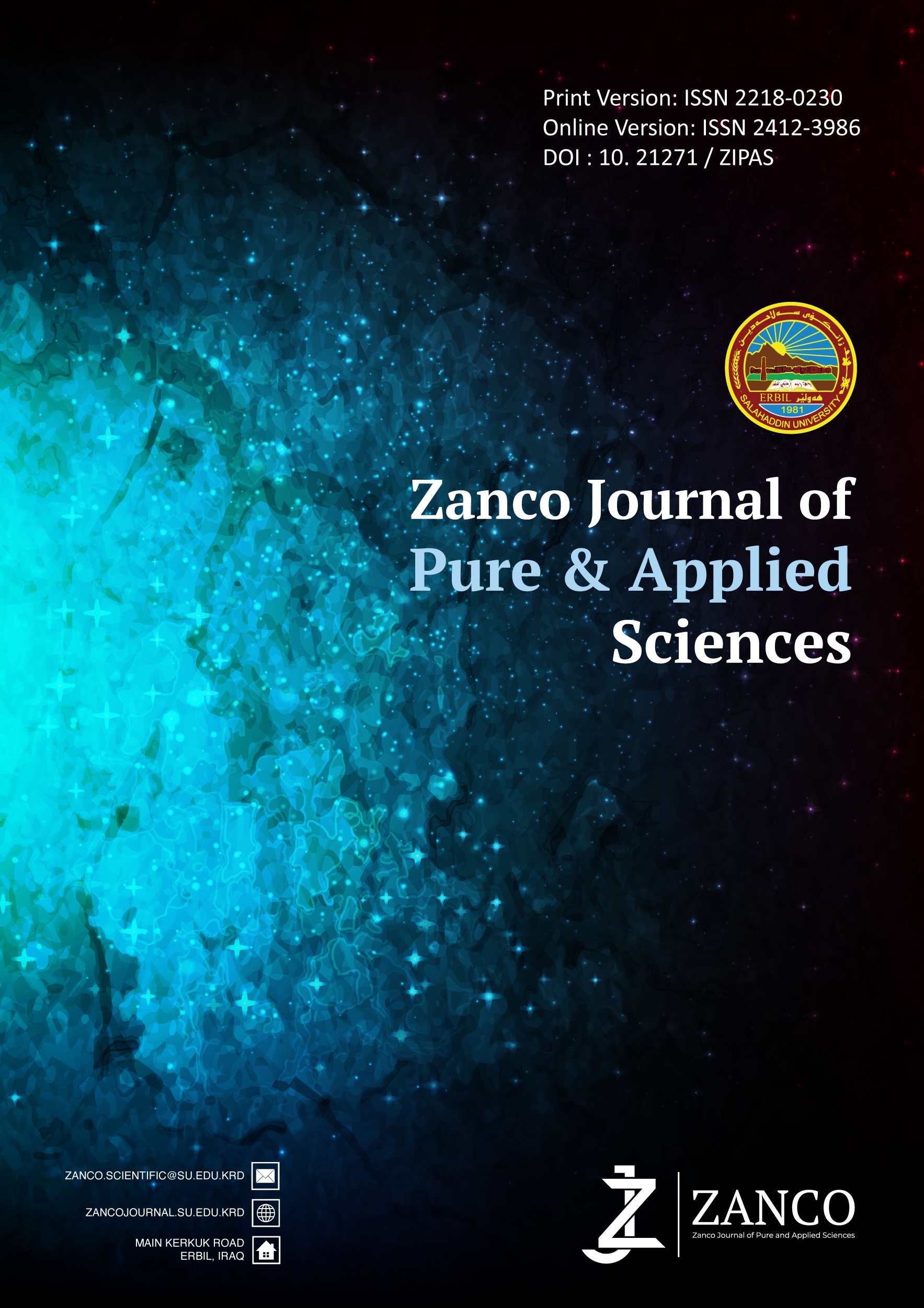Identification and quantification of the main organic components in artisanal apple vinegars from Iraq Kurdistan region by 1H NMR spectroscopy
DOI:
https://doi.org/10.21271/ZJPAS.36.2.10Keywords:
1H NMR spectroscopy, apple vinegars, quantitative; component analysisAbstract
The proton NMR spectra of apple vinegar samples obtained from the farms of Kurdistan region-Iraq, have been thoroughly examined and reported. Many organic molecules from various classes were assigned, including organic acids, alcohols, volatile compounds, and amino acids. Without extraction or pre-concentration processes, the possibility of quantifying the compounds that were present in the whole vinegar sample was also investigated. The results showed that 1H NMR with water suppression allows a quick simultaneous determination of acetic, formic, lactic, malic, succinic, tartaric acids, ethanol, methanol, acetoin, 2,3-butanediol, glucose and fructose, by using dimethyl sulfone (DMSO2) or potassium hydrogen phthalate (KHP) as internal standards. The 1H NMR method was applied to differentiation of the various samples of apple vinegar.
References
Amin, N. & Claridge, T. 2017. Quantitative NMR Spectroscopy. oxford university.
Andreotti, G., Lamanna, R., Trivellone, E. & Motta, A. 2002. 13C NMR spectra of TAG: an easy way to distinguish milks from different animal species. Journal of the American Oil Chemists' Society, 79, 123-127.
Andreotti, G., Trivellone, E., Lamanna, R., Di Luccia, A. & Motta, A. 2000. Milk identification of different species: 13C-NMR spectroscopy of triacylglycerols from cows and buffaloes’ milks. Journal of Dairy Science, 83, 2432-2437.doi: 10.3168/jds.S0022-0302(00)75133-2.
Belloque, J. and Ramos, M. 1999. Application of NMR spectroscopy to milk and dairy products. Trends Food Sci. Technol, 10, 313–320 https://doi.org/10.1016/S0924-2244(00)00012-1
Boffo, E. F., Tavares, L. A., Ferreira, M. M. & Ferreira, A. G. 2009. Classification of Brazilian vinegars according to their 1H NMR spectra by pattern recognition analysis. LWT - Food Science and Technology, 42,1455–1460. doi:10.1016/j.lwt.2009.05.008
Budak, N. H., Doguc, D.K., Savas, C. M., Seydim, A. C., Kok Tas, T., Ciris, M. I. & Guzel-Seydim, Z. B. 2011. Effects of apple cider vinegars produced with different techniques on blood lipids in high-cholesterol-fed rats. Journal of Agricultural and Food Chemistry, 59, 6638-6644. https://doi.org/10.1021/jf104912h
Caligiani, A., Acquotti, D., Palla, G. & Bocchi, V. 2007. Identification and quantification of the main organic components of vinegars by high resolution 1H NMR spectroscopy. Analytica Chimica Acta, 585, 110-119. https://doi.org/10.1016/j.aca.2006.12.016
Chen, T., Gui, Q., Shi, J. J., Zhang, X. Y. & Chen, F. S. 2013. Analysis of variation of main components during aging process of Shanxi Aged Vinegar, Acetic Acid Bacteria, 2, 31–38 https://doi.org/10.4081/aab. 2013.s1.e6
Cocchi, M., Lambertini, P., Manzini, D., Marchetti, A. & ulrici, A. 2002. Determination of carboxylic acids in vinegars and in Aceto Balsamico Tradizionale di Modena by HPLC and GC methods, J. Agric.Food Chem., 50, 5255-5261. https://doi.org/10.1021/jf020155l
Consonni, R. And Gatti, A., 2004, 1H NMR Studies on Italian Balsamic and Traditional Balsamic Vinegars, J. Agric. Food Chem. 52, 3446-3450
De las Heras, E., Z uriarrain-Ocio, A., Zuriarrain J., Bordagaray, A., Dueñas, M. T. & Berregi, I. J. F. 2020. Quantitative determination of acrolein in cider by 1H NMR spectrometry, Foods, 9, 1820. doi:10.3390/foods9121820
Erbe, T. & Brückner, H. 1998. Chiral amino acid analysis of vinegars using gas chromatography–selected ion monitoring mass spectrometry, Z Lebensm Unters Forsch A, 207, 400-409. https://doi.org/10.1007/s002170050352
Gil, A., Belton, P. & Hills, B. 1996. Applications of NMR to Food Science. Annual reports on NMR spectroscopy,32, 1-49 ,Elsevier. https://doi.org/10.1016/S0066-4103(08)60077-0
Gunduz, S., Yilmaz, H. & Goren, A. C. 2013. Halal food and metrology: Ethyl alcohol contents of beverages, J. Chem. Metrol., 7, 7-9.
Hemke, J., Rasane, P., Kaur, S., Kumbhar, P. & Singh, J. 2019. Vinegar a traditional functional food, Think India Journal ,22, 581-629.
Johnston, C.S. Steplewska, I. Long, C.A. Harris, L.N. & Ryals, R.H. 2010. Examination of the antiglycemic properties of vinegar in healthy adults. Annals of Nutrition and Metabolism,56, 74-79. https://doi.org/10.1159/000272133
Košir e, I. J. & Kidricˇ, J. J. 2001. Identification of amino acids in wines by one-and two-dimensional nuclear magnetic resonance spectroscopy. J. Agric. Food Chem., 49, 50-56. https://doi.org/10.1021/jf0008137
Le Gall L, G., Colquhoun, I. J. & Defernez, M. 2004. Metabolite profiling using 1H NMR spectroscopy for quality assessment of green tea, Camellia sinensis (L.). J. Agric. Food Chem., 52, 692-700. https://doi.org/10.1021/jf034828r
Masino, F., Chinnici, F., Franchini, G. C., Ulrici, A. & Antonelli, A. 2005. A study of the relationships among acidity, sugar and furanic compound concentrations in set of casks for Aceto Balsamico Tradizionale of Reggio Emilia by multivariate techniques. Food Chem., 92, 673-679. https://doi.org/10.1016/j.foodchem.2004.08.029
Nagashima, M. & Saito, K. 2010. Antioxidant activity of the new black vinegar “IZUMI”. The Journal of Nutrition, Health & Aging, 14, 845-849. https://doi.org/10.1007/s12603-010-0138-2
Nishikawa, Y., Takata, Y., Nagai, Y., Mori, T., Kawada, T.& Ishihara, N. 2001. Antihypertensive effect of Kurosu extract, a traditional vinegar produced from unpolished rice, in the SHR rats. Nippon Shokuhin Kagaku Kogaku Kaishi, 48, 73-75 https://doi.org/10.3136/nskkk.48.73
Nord, L. I., Vaag, P. & Duus, J. Ø. 2004. Quantification of organic and amino acids in beer by 1H NMR spectroscopy. Anal. Chem., 76, 4790-4798. doi: 10.1021/ac0496852.
Pauli, G. F., Chen, S.N., Simmler, C., Lankin, D. C., Gödecke, T., Jaki, B. U., Friesen, J. B., McAlpine, J. B. & Napolitan, J. G. 2014. Importance of purity evaluation and the potential of quantitative 1H NMR as a purity assay: miniperspective, J. Med. Chem., 57, 9220-9231. https://doi.org/10.1021/jm500734a
Pereira, G. E., Gaudillere, J., Van Leeuwen, C., Hilbert, G., Lavialle, O., Maucourt, M., Deborde, C., Moing, A. & Rolin, D.. 2005. 1H NMR and chemometrics to characterize mature grape berries in four wine-growing areas in Bordeaux, France. J. Agric. Food Chem., 53, 6382-6389. https://doi.org/10.1021/jf058058q
Perumpuli, P. A.B.N. & Dilruksh, D.M.N. 2022. Vinegar: A functional ingredient for human health. International Food Research Journal, 29, 959 - 974 https://doi.org/10.47836/ifrj.29.5.01
Plessi, M., Monzani, A. & Coppini, D. 1989. Quantitative determination of acids and derivatives in balsamic and other vinegars. Sciences des Aliments., 9, 179-183.
Sobolev, A. P., Segre, A.L. & Lamanna, R. M. 2003. Proton high‐field NMR study of tomato juice. Reson. Chem., 41, 237-245. https://doi.org/10.1002/mrc.1176
Wang, X., Wang, J., Kamal, G. M., Jiang, B., Sun, P., Zhang, X. & Liu, M. C. 2016. Characterization and comparison of commercial Chinese cereal and European grape vinegars using 1H NMR spectroscopy combined with multivariate analysis. Chin. J. Chem., 34, 1183-1193. http://dx.doi.org/10.1002/cjoc.201600365
Westwood, S., Yamazaki, T., Huang, T., Garrido, B., Ün, I., Zhang, W., Martos, G., Stoppacher, N., Saito, T. & Wielgosz, R. 2019. Development and validation of a suite of standards for the purity assignment of organic compounds by quantitative NMR spectroscopy. Metrologia, 56, 064001. DOI 10.1088/1681-7575/ab45cb
Woodams, E.E. & Hang Y. D. , 2010 Influence of apple cultivar and juice pasteurization on hard cider and eau-de-vie methanol content, Bioresource Technology 101 ,1396–1398.
Downloads
Published
How to Cite
Issue
Section
License
Copyright (c) 2024 Lana H. Chawishli

This work is licensed under a Creative Commons Attribution 4.0 International License.














